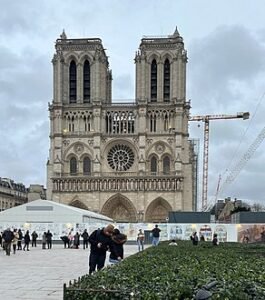
Paris, often referred to as the “City of Light,” stands as a living testament to centuries of rich history and cultural evolution. Beyond the contemporary hustle and bustle, the city’s historical landmarks tell the tale of its enduring legacy. In this exploration, we will journey through time, tracing Paris through the ages by delving into some of its most iconic historical landmarks.
The Notre-Dame Cathedral: Gothic Grandeur and Resilience
Our journey begins with the Notre-Dame Cathedral, a masterpiece of French Gothic architecture that has stood on the Île de la Cité for over 850 years. This towering cathedral, with its intricate facades and soaring spires, has witnessed key moments in French history, from royal coronations to the French Revolution.
While tragically damaged by a fire in 2019, the Notre-Dame Cathedral is a symbol of resilience and the collective will to preserve cultural heritage. Ongoing restoration efforts aim to revive this architectural marvel, ensuring that it continues to inspire awe for generations to come.
The Louvre Museum: From Fortress to Artistic Treasure Trove
Once a medieval fortress, the Louvre has transformed over the centuries into the world’s largest art museum. Its iconic glass pyramid entrance serves as a modern juxtaposition to the historical treasures within. Originally built as a royal palace, the Louvre became a public museum during the French Revolution, making art and culture accessible to all.
Today, the Louvre’s vast collection spans from ancient artifacts to Renaissance masterpieces, including the renowned Mona Lisa. The museum itself is a journey through time, reflecting the evolving tastes and values of Parisians and the world beyond.
Eiffel Tower: A Symbol of Innovation and Romance
No exploration of Parisian landmarks would be complete without the Eiffel Tower, an enduring symbol of both innovation and romance. Built for the 1889 Exposition Universelle, the tower was initially met with skepticism but soon became an iconic silhouette on the Parisian skyline.
Gustave Eiffel’s creation, initially intended to be a temporary structure, has evolved into a global symbol of love and a testament to Paris’s commitment to embracing modernity while preserving its cultural identity. The panoramic views from the tower provide a breathtaking perspective of the city, showcasing the marriage of past and present.
Versailles Palace: Opulence and Grandeur of the French Monarchy
A short journey from central Paris leads to the opulent Versailles Palace, a symbol of the absolute monarchy that once ruled France. The palace, with its grand halls, meticulously landscaped gardens, and Hall of Mirrors, was the seat of power during the reign of Louis XIV.
Versailles reflects the excesses of the French monarchy, but it also played a pivotal role in shaping European history. The opulence of Versailles stands as a stark contrast to the revolutionary fervor that would later reshape the political landscape of France.
The Pantheon: A Temple of Enlightenment Ideals
Built as a church dedicated to St. Genevieve, the Pantheon underwent a transformation during the French Revolution into a secular mausoleum honoring the nation’s great minds. The crypt houses the remains of influential figures like Voltaire, Rousseau, and Marie Curie, symbolizing the shift from religious authority to Enlightenment ideals.
The neoclassical architecture of the Pantheon reflects the intellectual aspirations of a society in transition, emphasizing reason and human achievement over divine authority. Today, it stands as a tribute to the pursuit of knowledge and the individuals who have shaped the course of French history.
Conclusion: A Tapestry Woven with Time
As we trace Paris through these historical landmarks, we witness the city’s transformation from a medieval fortress to a beacon of art, culture, and enlightenment. Each landmark tells a chapter in the story of Paris, weaving together a tapestry of time that connects the past to the present.
From the Gothic grandeur of Notre-Dame to the innovative silhouette of the Eiffel Tower, these landmarks serve as enduring symbols of the city’s resilience, adaptability, and commitment to preserving its cultural heritage. As visitors and Parisians alike continue to explore these historical treasures, they contribute to the ongoing narrative of a city that has stood the test of time, leaving an indelible mark on the world stage.
